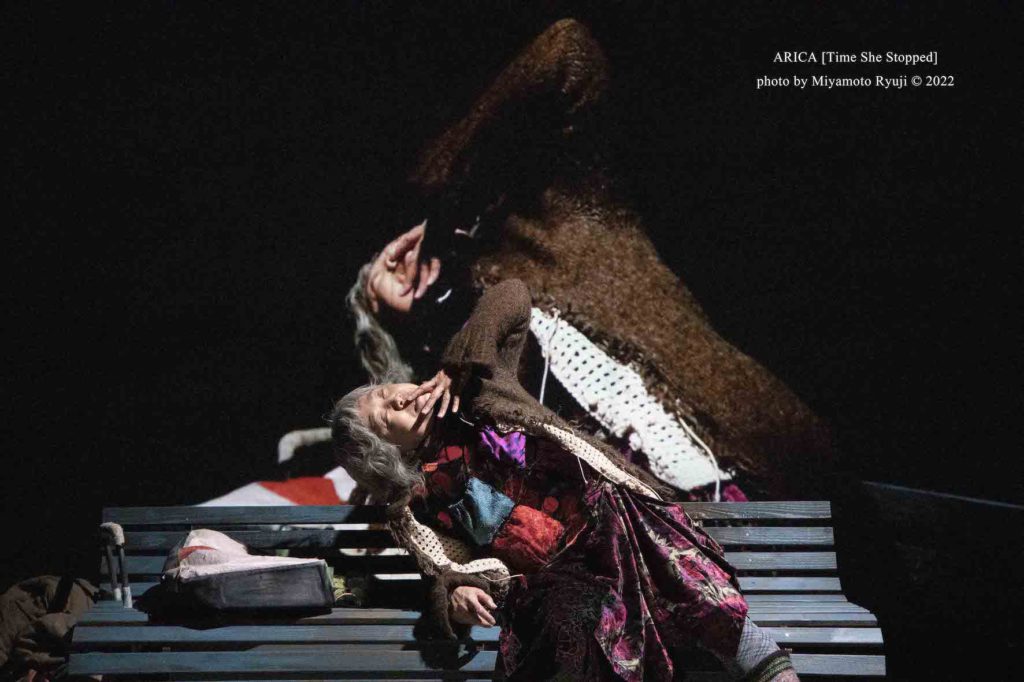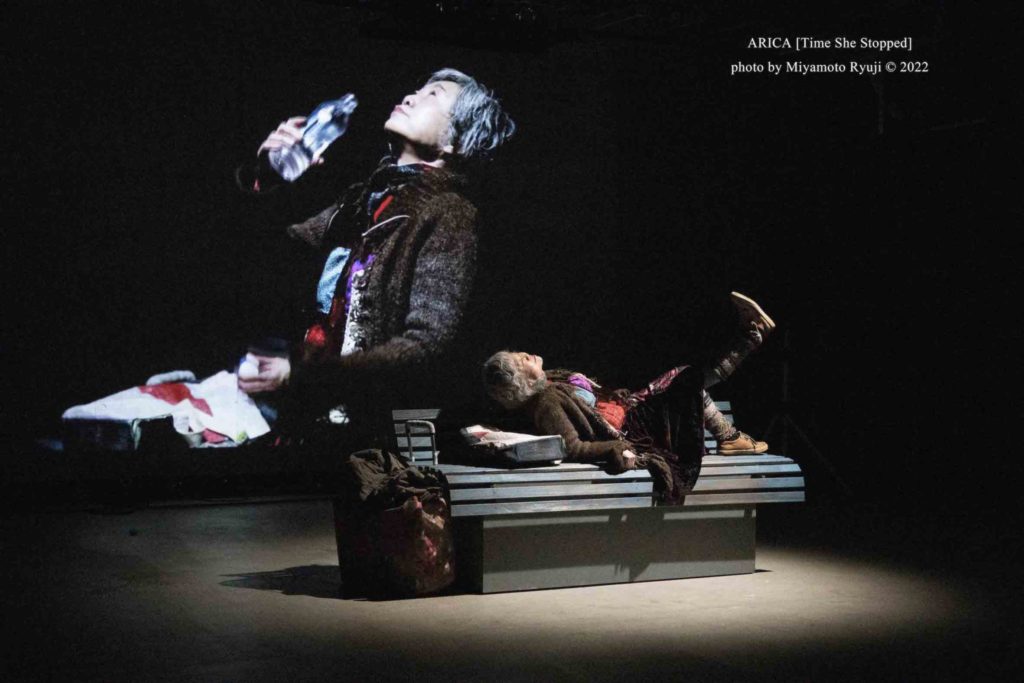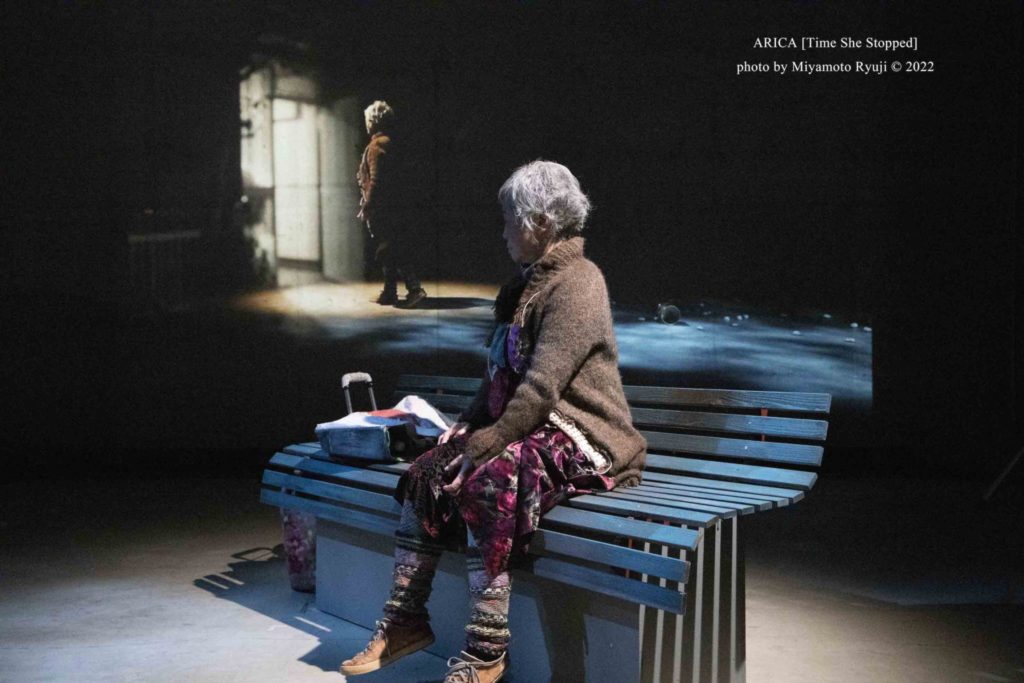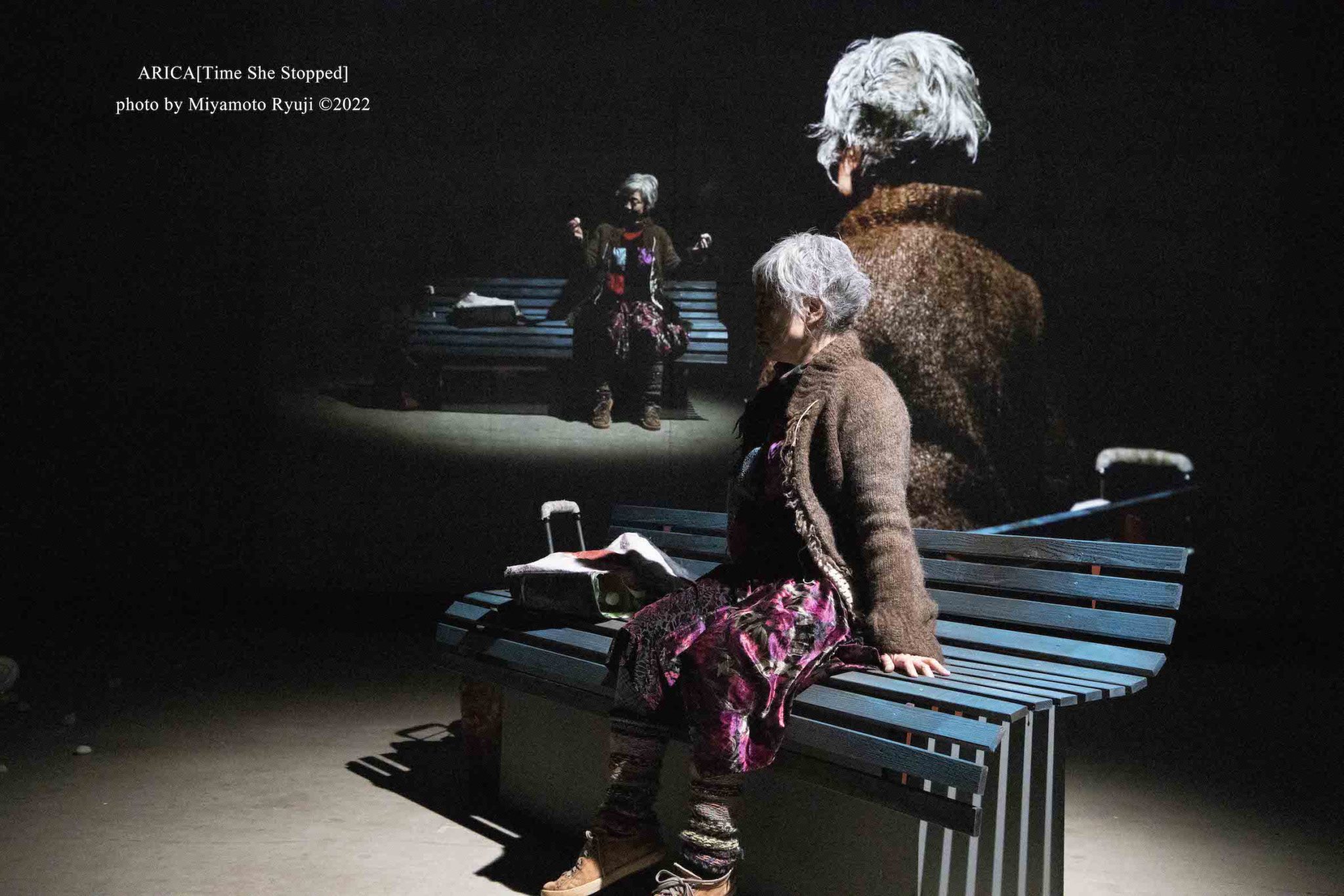Art journalist. Holds a Master’s Degree from Tokyo University of the Arts with a major in Art. Part-time lecturer of the Joshibi University of Art, the Kokugakuin University and the Tokyo University of the Arts. Author of “The Secret of Western Paintings” (Asahi Press Co., Ltd.), and has co-authored many books including “Western Museum”, “Weekly Museum” (Shogaukan Inc.), “History of Nude in Art” (Bijutsu Shuppan-Sha Co., Ltd.), “The Book that helps you Understand Contemporary Art” (Yousensha Co., Ltd.), etc.. Traslator of ” A Concise History of Modern Sculpture ” by H. Read (Gensousha Ltd.), ” Urban Space Art ” by C. Grout (Kajima Institute Publishing Co., Ltd), ” Art & Telematics ” by R. Ascott (NTT Publishing Co., Ltd), ” Leonardo Da Vinci ” by M · Kemp (Otsukishoten), ” But is this art? ” by C .Freeland (Brucke Publishing Inc.) etc..
Photo: Miyamoto Ryuji ©︎ 2022 ARICA “Time She Stopped”
An old woman lies alone, sleeping on a bench with a tote bag as her pillow. Beside the bench stands a hand truck with two bags tied to it. The woman wakes up, rises, and drinks water from a plastic bottle, mouthing something without making a sound. She puts an elbow on the bench, swings her legs up and starts singing “Lips Stay Silent” from the operetta “The Merry Widow.” But as she sings with a happy expression on her face, a mosquito suddenly attacks her. She kills the insect perched on her cheek and shakes off the spit in her palm. Then, touching her face and body with her hands, she mutters “Lips, eyes, nose, neck, breasts” as if confirming the presence of her own body.
For some reason, the four pockets of the blouse she is wearing have pebbles in them. She rubs her breast and belly pockets with both hands and pulls out two pebbles from the right breast pocket. She hits the two stones together and laughs with happy glee. The sound of ambulance sirens and cars running can be heard from afar. Yes, she is homeless. She puts one pebble in her pocket, lovingly licking the other in her left hand before tucking that one into her belly pocket. She keeps taking the pebbles out and putting them back for a while, but seems unhappy with something. She looks skeptically at one pebble, then throws it into her mouth. But after a while, she pops it back out and throws it away.
The woman suddenly gets a runny nose. She hurriedly pulls out a large handkerchief from the bag and blows her nose. Something slips out of the handkerchief, making a loud noise. A small black bag, containing a key with a bell on it. She gazes at the key with a smile and goes to turn it slowly, but immediately decides to return it to the bag, wrapped in the handkerchief. A dog howls. The woman turns around and starts counting something with the fingers on her left hand.

Photo: Miyamoto Ryuji ©︎ 2022 ARICA “Time She Stopped”
Here, for the first time, her voice echoes clearly through the hall. “Counting / Being inside or outside / Always, for ever / The wind won’t blow.” But these lines are pre-recorded. The actual voice of the old woman in front of us only sings “Lips Stay Silent,” utters unintelligible cries and words, and speaks the names of her own body parts. She picks up the plastic bottle again, shakes it with a jerk, and puts it away in her bag. Then, a can about 18 centimeters in diameter suddenly rolls out from the right side of the stage. The woman gets up and, following the can, walks slowly toward the left side.
A row of footlights behind the woman lights up. In the glow of the spotlight illuminating the left side of the stage, she takes out her keys. But with a resigned look, she puts them in her pocket and returns to the bench. (The footlights turn off.) She turns around, as if to confirm something. The lights that illuminate her sitting on the bench fade out.
Thus ends the first sequence. This is repeated four times, with a series of subtle repetitions and differences in the woman’s recorded voice and her gestures guiding the story toward its conclusion.
The second sequence begins. As the woman awakens from her sleep, a close-up of her figure is shown behind her, shot from a right-side angle. The old woman’s actions in the real space and those in the video are perfectly synchronized. As I wonder whether the video is a live feed, the can starts rolling again. As the protagonist stands up, seemingly guided by the can, the video in the background shows her from behind, the lights of the city twinkling in the distance, dead grass at her feet, and we hear the sounds of the streets. She gets up from a (public) park bench and slowly heads off somewhere. (The footlights turn on.) Then, in the video, the door of a white-walled house appears in front of her. She steps to the door and holds out her key, but a voice says, “Stop.”
Her shoulders slump in resignation. Another voice is heard: “It’s nothing / For a long time / Staying here with no other choice / Staying here for nothing / I’ve shut myself inside me/Alone even when being outside/Time to stop/Time to stop / No movement No shaking / Resting with no other choice / Sitting down on the communal bench / Sitting still in the communal square / Counting all members / Not all members being here Some disappear / Counting / Being inside or outside / Always, for ever / The wind won’t blow / Not to me / Just in front of my eyes / Someone halts / Someone leaves / Being still on the communal bench / Likewise, being here with no other choice / Staying here / It’s nothing / For a long time / I’ve shut myself inside me / Alone even when being outside / Time to stop / Time to stop…” She returns to the bench again. (The footlights go out.) Darkness falls.
The sleeping old woman, for the third time. A dog howls. The close-up footage on the screen lags behind the old woman’s real-time movements. Here, I notice: Both the sounds we hear and the images we see have been recorded in advance. The old woman in the image is larger than in reality. It’s as if the woman in front of us, who has a real body, is trapped in the larger “self” of the footage. The real “self” is absorbed into the “larger self” of the image…The body of Tomoko Ando, the actor we see, becomes dreamlike, losing her substance, while the non-existent body of “Tomoko Ando” on the huge screen acquires a sense of reality. In this impossible exchange between virtual and real, the audience’s own existentiality begins to unravel. The viewer wonders, “Where do I exist now?”…
At the end of the fourth sequence, the old woman in the video unlocks the door of the white house that appears before her. A bright light shines from inside the house, and she also glows white. She takes a step toward the house. That is the end of her life. The end of a life of abandonment and loneliness. But in this light-filled ending, one may sense a faint, faint redemption, though one ever in danger of slipping through one’s fingers…

Photo: Miyamoto Ryuji ©︎ 2022 ARICA “Time She Stopped”
The words “Alone even when being outside” exude the loneliness of someone who has lost the community to which he or she belongs. But at the same time, they echo the words of the elderly woman in ARICA’s “Time She Stopped—Revisiting Rockabye” (performed at Kyoto University in July 2019), who at the end of her life, shut up in her house, says “A chair / I tell the chair / at the end / Let me sleep / I want you to close my eyes / Let me die / Close my eyes / Let me sleep / Let me sleep.” Whether or not one has a home, people are lonely beings, and death is where this lonely being’s “time” stops…In “Time She Stopped—Revisiting Rockabye,” the old woman’s “time” appears to end with the natural death she wishes for, but in this version, the lines “One is coming down the street / Even if no one else comes, just one will come / Will come sometime / The day has come at last / At last,” drive home that it is not natural death that brings an end to this old woman’s life.

Photo: Miyamoto Ryuji ©︎ 2022 ARICA “Time She Stopped”
I’m reminded of an incident that occurred around 4 a.m. on November 16, 2020. A homeless woman who was sleeping on a bench at a bus stop in Hatagaya, Shibuya-ku, was beaten on the head and killed. Just because she “was in the way.” A look into the abyss of Japanese society, in which both compassion and empathy for others are being lost. Was it her fault that she lost her job and became homeless due to the pandemic? She was just spending the night on a bus stop bench. And, at any moment, you or I may face the same absurd fate she did. The text was drafted by concept writer Shino Kuraishi four months before the incident. One shudders at the actualization of the times depicted by the intuition of those who create. I hope that as many people as possible will get to experience this work, because it conveys through a mixture of live acting, recorded video, and audio, without shouting out loud, the pain in the life of a woman who was beaten to death, and our sorrow in the face of that pain. I strongly hope that “Time She Stopped” will be distributed in disc format or provided as pay-to-view online content.
Translated by Ilmari Saarinen
INFORMATION
ARICA + Noriko Koshida “Time She Stopped” in Yokohama
Venue: BankART Station
Date: December 7 -11, 2022
Direction: Yasuki Fujita
Image, concept: Noriko Koshida
Text: Shino Kuraishi
Performance: Tomoko Ando
Sound, performance: Yutaka Fukuoka
Device: Eijiro Takahashi
Costume: Yoko Ando
Costume production: Naoya Watanabe
Lighting: Takeaki Iwashina
Sound effect: Yuichi Tanaka
Publicity graphic: Yuri Suyama
Production: Satoshi Fukuoka, Keizo Maeda









